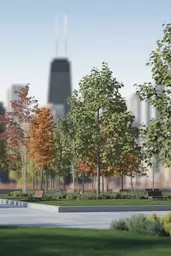Enhancement of Tree Health
Regular pruning removes unhealthy branches, leading to improved growth.
Subscribe to get expert tips and the latest insights on tree care and urban greening directly to your inbox.
Posted on: 2025-05-03
By: Keira Vallejo
Understanding the major advantages of proper pruning can significantly enhance urban environments. Below are the essential benefits visually represented.
Regular pruning removes unhealthy branches, leading to improved growth.
Reduces the risk of falling branches, ensuring safety for people and property.
A well-pruned tree enhances neighborhood beauty, creating inviting atmospheres.
Pruning stimulates new shoots, promoting a fuller canopy and vibrant foliage.
When it comes to caring for urban trees, proper pruning is like a health check-up for these giants. As someone deeply passionate about urban forestry, I can’t stress enough how vital it is for enhancing not just the trees’ health but the overall beauty of our city landscapes. In this section, I will shed light on the key benefits of strategic pruning, explaining why it’s essential for thriving urban environments.
Pruning isn’t just about cutting branches; it's about providing our trees with the best chance to flourish. By removing dead or diseased limbs, we allow for better air circulation and sun exposure, which can prevent diseases and pests. Ultimately, strategic pruning helps our trees live longer, healthier lives, ensuring they remain a cherished part of our urban canopy.
Let’s dive deeper into why pruning holds such significance for urban trees. Here are some key benefits that I’ve seen in my work with Urban Canopy Blog. For more information on selecting the right trees for your urban space, check out our guide on selecting trees for urban spaces.
These benefits highlight the profound impact that appropriate pruning can have on urban environments. When we take the time to invest in our trees, we are ultimately investing in the well-being of our communities!
The first and foremost benefit of proper pruning is enhancing tree health and longevity. Just like us, trees require care to thrive. By regularly inspecting and pruning our trees, we can remove any dead or infected branches that threaten their vitality.
Moreover, pruning allows trees to focus their energy on new growth rather than maintaining struggling limbs. This not only extends their lifespan but also contributes to a more robust urban ecosystem, providing cleaner air and better habitats for wildlife.
Have you ever noticed how a well-pruned tree stands out in a neighborhood? It’s like a work of art! Pruning enhances the aesthetic appeal of trees, making them more visually pleasing and structurally sound.
By shaping trees and removing overcrowded branches, we help them develop a strong framework. This not only improves their overall look but also contributes to their health by reducing competition for resources. A structured tree can withstand storms better, adding another layer of safety to our urban areas.
Did you know? Regularly scheduled pruning not only enhances the health of your urban trees but can also help in identifying potential issues before they become serious problems. Keeping a pruning calendar can ensure that you address tree care at the right intervals, allowing for timely interventions that promote optimal growth and longevity.
As we wrap up our discussion on urban tree pruning, it's essential to reflect on the crucial role that proper tree maintenance plays in the overall health of our green spaces. Regular pruning can lead to healthier trees that not only thrive but also enhance the beauty of our neighborhoods. Remember, every snip and cut is a step towards creating a vibrant urban canopy that benefits everyone!
Think about the benefits of regular pruning. It’s not just about aesthetics; it promotes tree health, improves safety, and can even increase property values! By making tree maintenance a priority, we are investing in our city’s future. I encourage you to keep these benefits in mind as you engage with your trees and your community. For more information on how to protect your urban trees from the summer heat, see our post on summer tree care.
When it comes to urban forestry, the importance of proper tree maintenance cannot be overstated. Regular pruning helps prevent disease, reduces hazards, and encourages robust growth, making it a vital practice for any urban arborist. Whether you're a seasoned tree care expert or just starting, understanding the fundamental principles of pruning can make all the difference.
Here are some key points to remember about the importance of proper tree maintenance:
Regular pruning is like giving your trees a gentle haircut! It not only helps them stay healthy but also fosters a stronger and more beautiful tree structure. I've seen firsthand how trees that receive consistent care flourish, creating green havens in our urban environments. Learn more about the connection between trees and property values in our article: Trees and Property Value.
Moreover, when we look at the long-term benefits of regular pruning, it becomes clear that investing time and effort into tree care pays off. Trees that are well-maintained can contribute to environmental benefits such as improved air quality and enhanced biodiversity. So, let's commit to making regular pruning part of our urban forestry practices!
As we promote effective tree care, it's vital to stress the importance of safety in pruning practices. Urban environments present unique challenges, from traffic to pedestrian safety. Ensuring that we follow safe pruning techniques protects not only ourselves but also our community. For more information on the benefits of professional tree care, visit our post on professional tree care.
Here are some safety tips every urban arborist should consider:
At Urban Canopy Blog, we believe that fostering a community around tree care can lead to healthier urban landscapes. Engaging with fellow tree enthusiasts is a fantastic way to share knowledge and experiences. If you ever have questions about pruning or want to learn more, don't hesitate to reach out!
It’s important to have your questions answered so you can care for your trees confidently. Here are some frequently asked questions about pruning urban trees that might help you:
The frequency of pruning varies by tree species and age, but generally, young trees benefit from pruning every 2-3 years. Mature trees may need less frequent attention, perhaps every 3-5 years, depending on their health and structure.
Look for these signs that indicate your tree might need some care:
For those who want to dive deeper into urban tree care, there are many resources available. Here’s a list of helpful guides and connections:
Don’t hesitate to reach out to local arborists for hands-on guidance or advice tailored to your specific tree species. Many arborists are passionate about sharing their knowledge and can provide invaluable insights!
Consider participating in local workshops or community events focused on tree care. These opportunities allow you to learn from experts and connect with others who share your passion for enhancing urban greenery!
Here is a quick recap of the important points discussed in the article:

 In urban environments, trees are often the unsung heroes contributing to our well-being and the over
In urban environments, trees are often the unsung heroes contributing to our well-being and the over
 Urban trees are essential to our cities, yet they face numerous threats from pests and diseases. Did
Urban trees are essential to our cities, yet they face numerous threats from pests and diseases. Did
 Did you know that urban tree diversity is crucial not just for aesthetics, but for the health of ent
Did you know that urban tree diversity is crucial not just for aesthetics, but for the health of ent